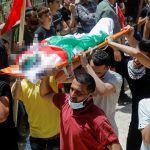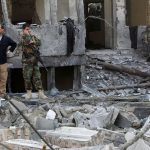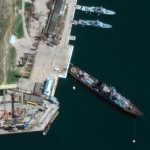The prime minister of Sri Lanka, Mahinda Rajapaksa, has reportedly offered his resignation after anti-government demonstrators clashed with police who used tear gas and water cannon in the capital Colombo.
The resignation report from an official comes as a curfew has been imposed on the whole of Sri Lanka after government supporters attacked protesters camped outside the president and prime minister’s offices.
“The prime minister has sent his letter of resignation to the president,” the official said, declining to be named.
President Gotabaya Rajapaksa is the prime minister’s younger brother.
The resignation of the prime minister means that the entire cabinet is dissolved, paving the way for a new government.
Three other high-profile Rajapaksa family members have already stepped down from their government roles.
It comes as trade unions begin a “week of protests” demanding the government change and the president step down over the country’s worst economic crisis in memory.
Sri Lanka is on the brink of bankruptcy and has suspended payments on its foreign loans.
Sri Lanka food crisis: How shortage of fuel and rising prices affect entire economy
Sri Lanka ‘risks running out of food and fuel’ and could descend into ‘anarchy’, former energy minister says
Sri Lanka: One dead and 10 injured as police open fire on protesters demonstrating against fuel price rises
Its financial woes have brought on a political crisis, with the government facing widespread protests and a no-confidence motion in parliament.
The country’s government last week declared a state of emergency for the second time in five weeks, but public discontent has steadily simmered.
Supporters of Mahinda Rajapaksa rallied inside his office earlier, urging him to ignore the protesters’ demands to step down and requesting he remain in office.
Hundreds of ruling party supporters also rallied outside the prime minister’s official residence before marching
to an anti-government protest site outside the presidential office.
Police had formed a line of personnel ahead of time on the main road leading towards the site but did little to stop
pro-government protesters from advancing, according to a Reuters witness.
Pro-government supporters, some armed with iron bars, attacked anti-government demonstrators at the “Gota Go Gama” tent village that sprang up last month and became the focal point of the nationwide protests.
Police used dozens of tear gas rounds and water cannon to break up the confrontation, the first major clash between
pro-and anti-government supporters since the protests began in late March.
At least nine people were taken to Colombo’s National Hospital for treatment after suffering injuries or inhaling
tear gas during the clashes, a hospital official said, declining to be named.
“This is a peaceful protest,” Pasindu Senanayaka, an anti-government protestor told Reuters. “They attacked Gota Go Gama and set fire to our tents.”
Read more:
How shortage of fuel and rising prices affect entire economy
Sri Lanka ‘risks running out of food and fuel’
Dozens of paramilitary troops with riot shield and helmets were deployed to keep both groups apart after the initial clashes. The army said it had also deployed soldiers in the area.
“Strongly condemn the violent acts taking place by those inciting & participating, irrespective of political allegiances,” President Rajapaksa said in a tweet.
“Violence won’t solve the current problems.”
Facing bankruptcy
Hit hard by the pandemic, rising oil prices and tax cuts, Sri Lanka has as little as $50m (£40m) of useable foreign reserves, Finance Minister Ali Sabry said last week.
The government has approached the International Monetary Fund for a bailout, and has been holding a virtual summit with officials from the multilateral lender aimed at securing emergency assistance.
Long queues for cooking gas seen in recent days have frequently turned into impromptu protests as frustrated
consumers blocked roads.
Domestic energy companies said they were running low on stocks of liquid petroleum gas mainly used for cooking.
Sri Lanka needs at least 40,000 tonnes of gas each month, and the monthly import bill would be $40m (£32m) at current prices.






















